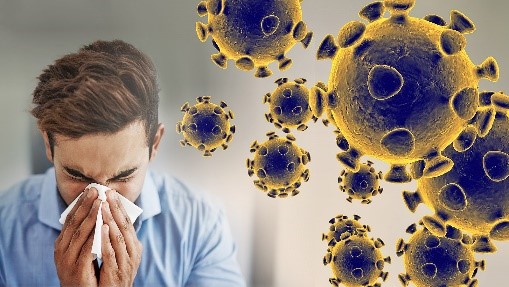Disinfection & Sanitisation Services in the fight against vary pathogens, including coronavirus
Ultraviolet Vs Coronavirus
In the past 40 years, UV lamps have been used for the sanitisation of air and surfaces in hospitals, laboratories, surgery rooms and operating theatres, where the hygiene and free pathogen environment was crucial.
In light of the current epidemic outbreak, UV is the most tested technology in the fight against Coronavirus family viruses.

Viruses are parasites that are biologically active only within their host. Viruses can be transmitted in different ways, including direct and indirect contact, vector carrying, and vehicle transmission. For deadly viruses such as Severe Acute Respiratory Syndrome (SARS) virus, influenza virus, and enterovirus, the vehicle transportation pathways include respiratory deliverance by droplets and aerosols, as well as faecal-oral transmission via water, food, and environmental surfaces. To reduce infection risk from virus infection, control methods for inactivating such viruses have been extensively researched (Jensen 1964; Gerba et al. 2002; Shin et al. 2003; Thurston-Enriquez et al., 2003). Among these control methods, ultraviolet germicidal (UVC) was demonstrated to be extremely efficient for virus inactivation (Jensen 1964; Galasso et al. 1965; Gerba et al. 2002; Nuanualsuwan et al. 2003; Thurston-Enriquez et al., 2003).

oThe mechanisms of UVC on microbes are uniquely defenceless to light at wavelengths at or near 253.7 nm, because of the maximum penetration wavelength of a DNA molecule is 260 nm. The pyrimidine of DNA base can completely absorb UV light. After irradiation, the DNA sequence where pyrimidine and pyrimidine a link can form pyrimidine dimers. These dimers can change the DNA double helix structure and interfere with DNA duplication, as well as lead to the destruction of the replicate ability of cells and thus render the cells non-infectious (Brickner et al. 2003).
Answers to Frequently Asked Questions
- How long does coronavirus (SARS-CoV-2) Live on Surfaces?
6 hours – 9 days on surfaces
- What is the difference between a virus and bacteria?
Bacteria are self-contained, have cell walls, and can survive and replicate on their own.
Viruses are DNA molecules that may be uncovered or encapsulated and need a host to replicate. They cannot be treated with antibiotics and require a vaccine.
- What is the biggest issue with this coronavirus (SARS-CoV-2) virus?
High secondary infection rate, Rapid expanse (more rapid than SARS or MERS), Fatality rate (2-3%)
- Is ultraviolet light effective against coronavirus (SARS-CoV-2)?
Ultraviolet light destroys the DNA of viruses, bacteria, and fungi
Coronaviruses are portions of the Coronaviridae group and include a single-stranded, positive-sense RNA genome surrounded by a corona-like helical envelope (Ryan 1994). Approximately 100 sequences of the SARS-CoV-2 genome have been issued, and these suggest there are two types, Type I and Type II, of which the latter came from the Huanan market in China while the Type I strain came from an unknown location (Zhang 2020).
The genome consists of 29,751 base pairs (NC_045512.2) and the genome is about 80% homologous with SARS viruses (NCBI 2020, Fisher 2020). Coronaviruses have a dimension range of 60-140nm, with a mean size of 0.10 microns (Zhu 2020).
Download the Journal of virological methods regarding the Inactivation of the coronavirus that induces severe acute respiratory syndrome, SARS-CoV
The table below summarises the results of studies that have been performed on Coronaviruses under UV light exposure, with the specific species indicated in each case. The D90 value indicates the ultraviolet dose for 90% inactivation. Although there is a broad spectrum of variation in the D90 values, this is typical of laboratory researches on ultraviolet susceptibility. The range of D90 benefits for coronaviruses is 7-241 J/m2, the mean of which is 67 J/m2, should adequately represent the ultraviolet susceptibility of the SARS-CoV-2 virus.
| Microbe |
D90 Dose J/m2 |
UV k m2/J | Base Pairs kb | Source |
| Coronavirus | 7 | 0.35120 | 30741 | Walker 2007a |
| Berne virus (Coronaviridae) | 7 | 0.32100 | 28480 | Weiss 1986 |
| Murine Coronavirus (MHV) | 15 | 0.15351 | 31335 | Hirano 1978 |
| Canine Coronavirus (CCV) | 29 | 0.08079 | 29278 | Saknimit 1988b |
| Murine Coronavirus (MHV) | 29 | 0.08079 | 31335 | Saknimit 1988b |
| SA R S Coronavirus CoV-P9 | 40 | 0.05750 | 29829 | Duan 2003c |
| Murine Coronavirus (MHV) | 103 | 0.02240 | 31335 | Liu 2003 |
| SARS Coronavirus (Hanoi) | 134 | 0.01720 | 29751 | Kariwa 2004d |
| SARS Coronavirus (Urbani) | 241 | 0.00955 | 29751 | Darnell 2004 |
| Average | 67 | 0.03433 | ||
a (Jingwen 2020) b (estimated) c (mean estimate ) d (at 3 logs )
The above information has been published by ResearchGate.net regarding the susceptibility of Coronavirus to UV light.

